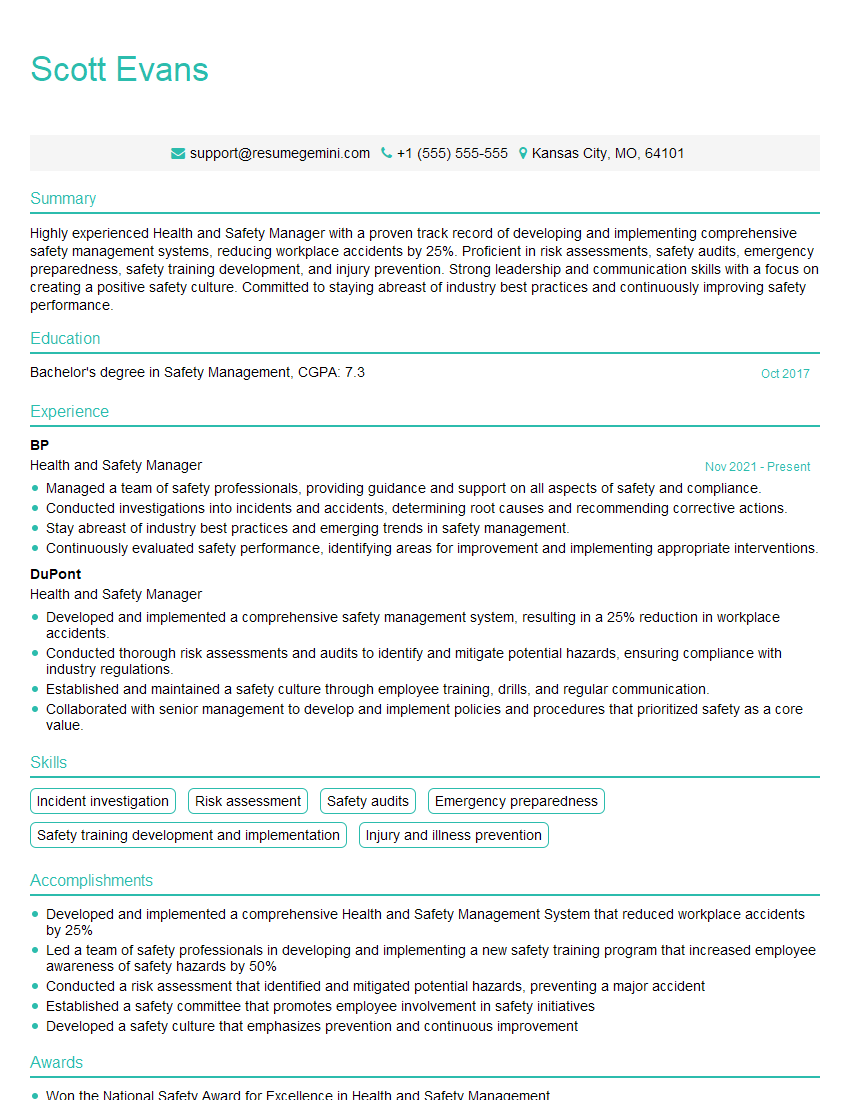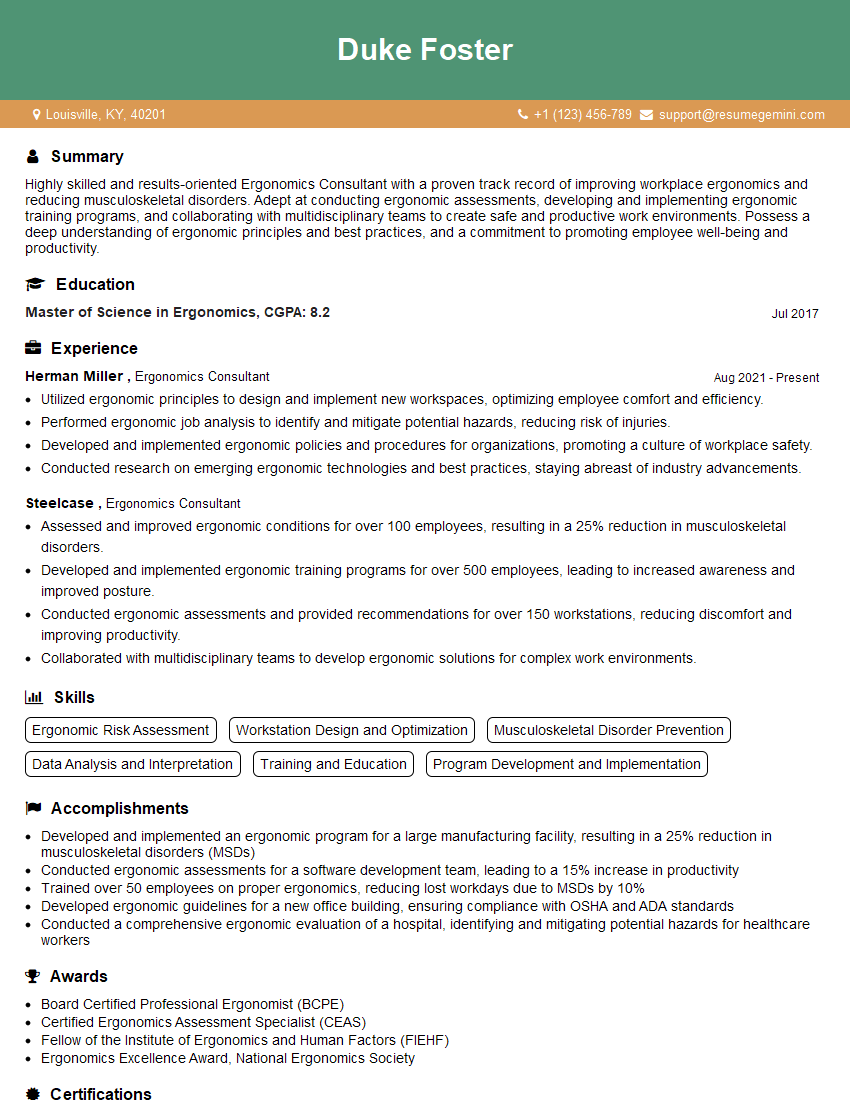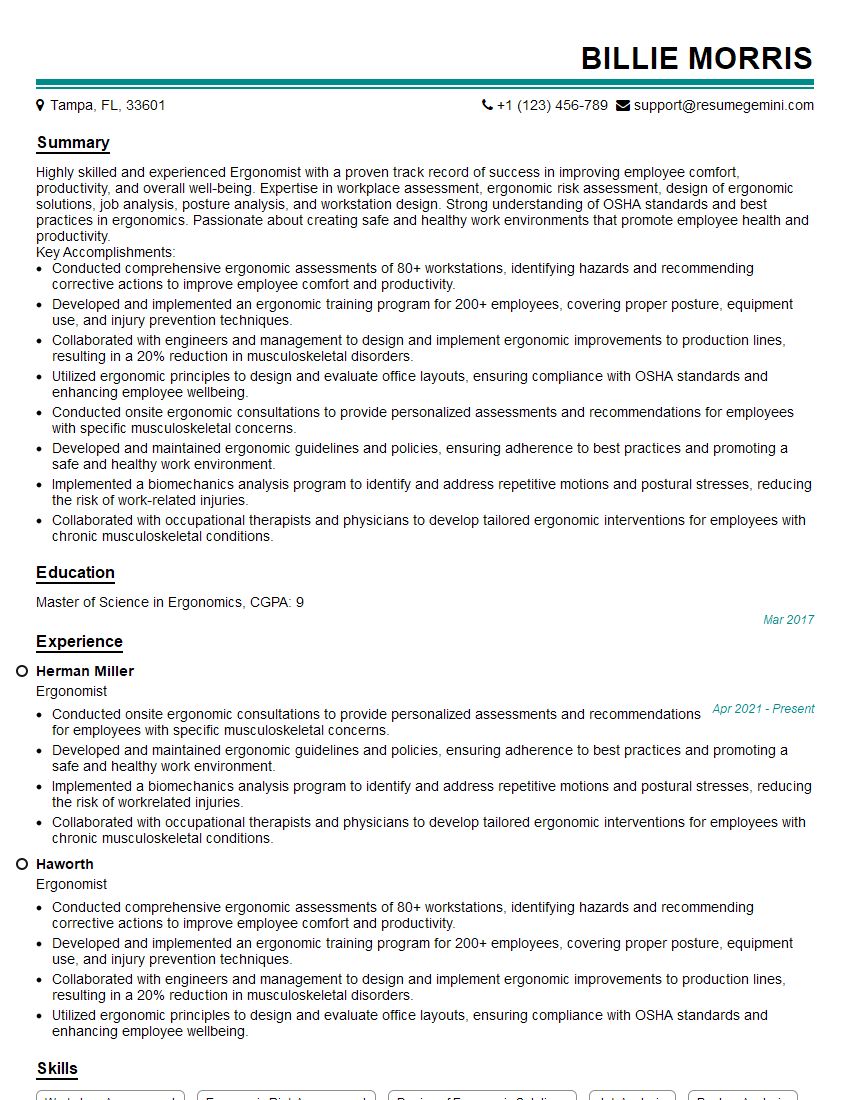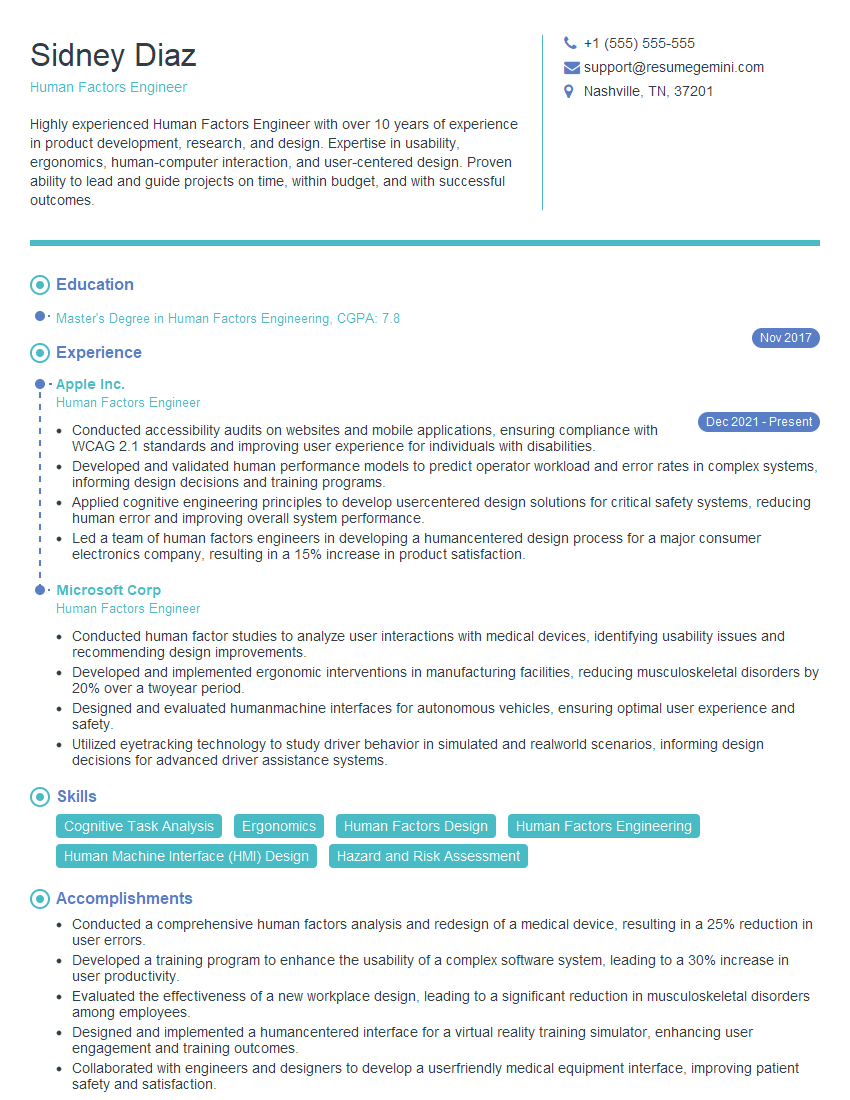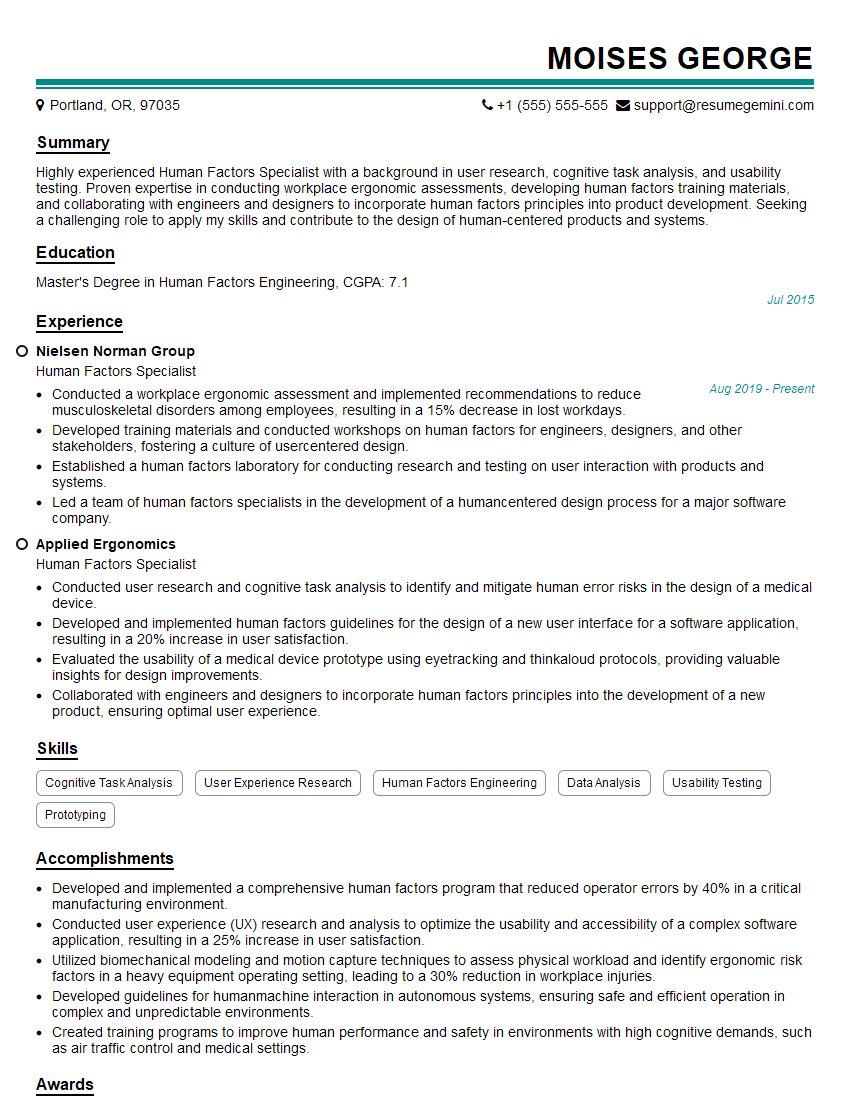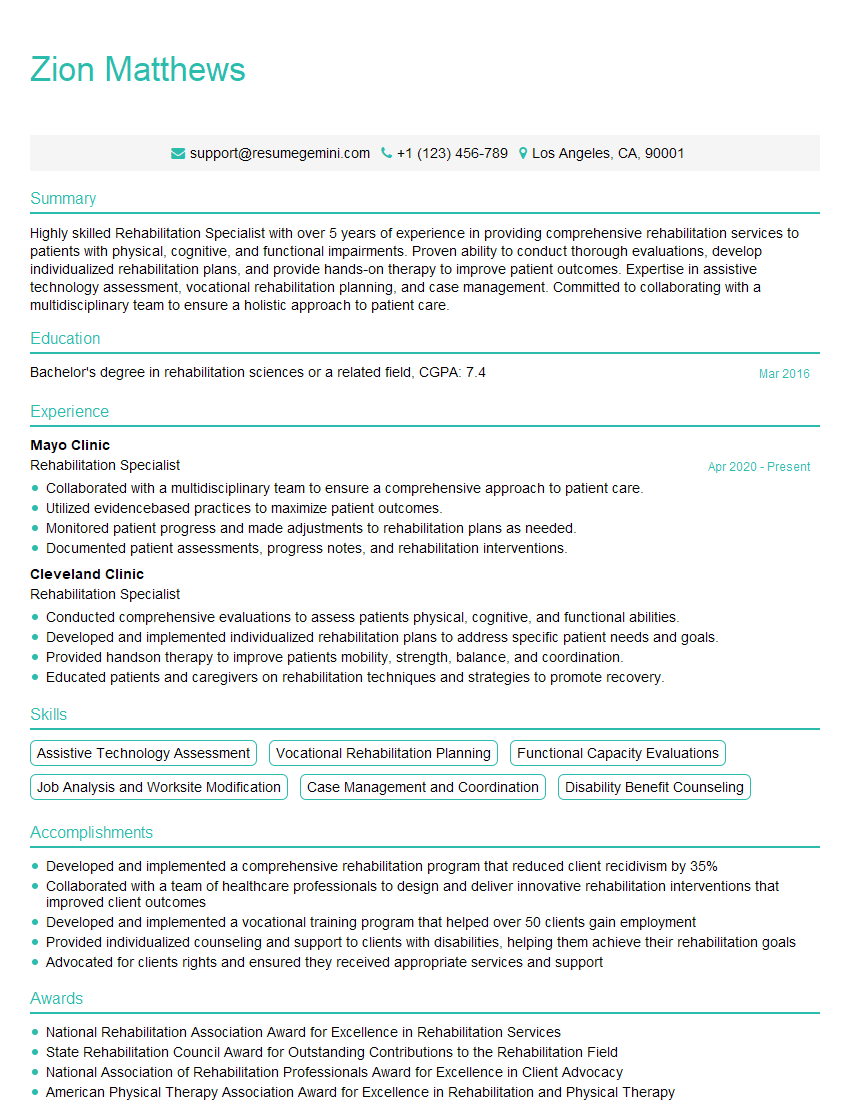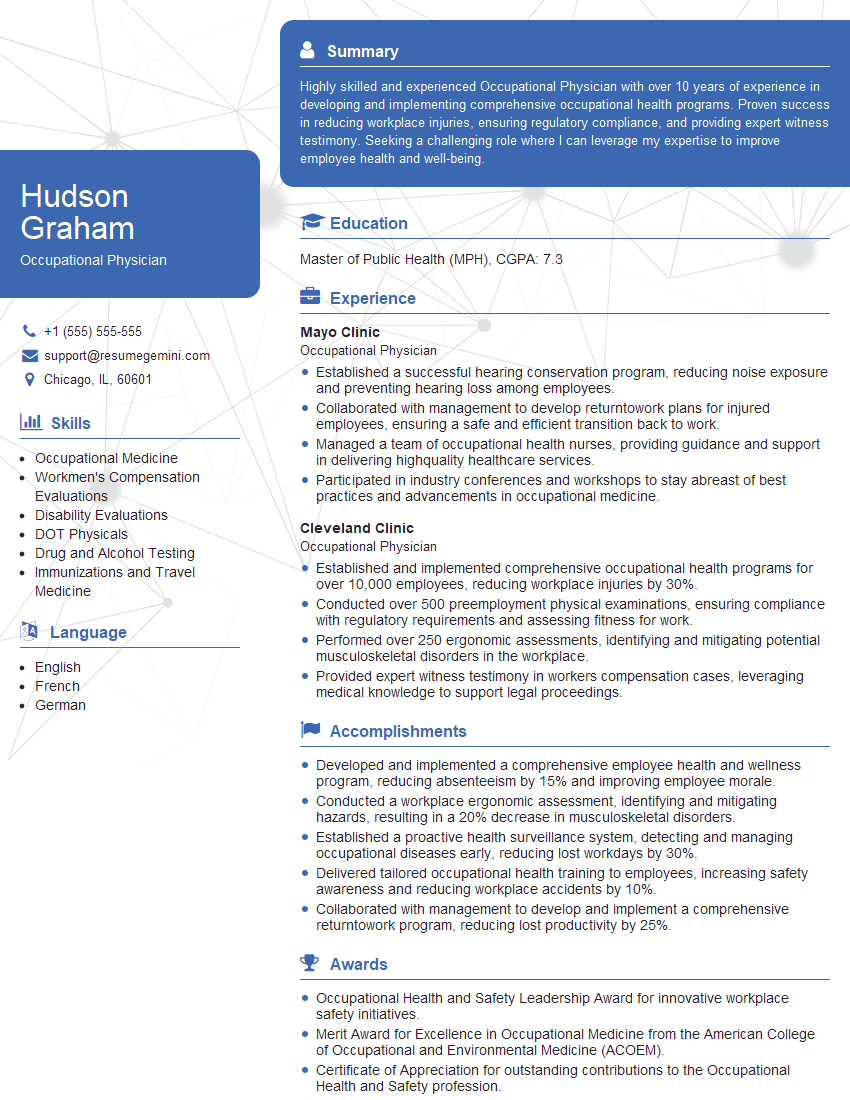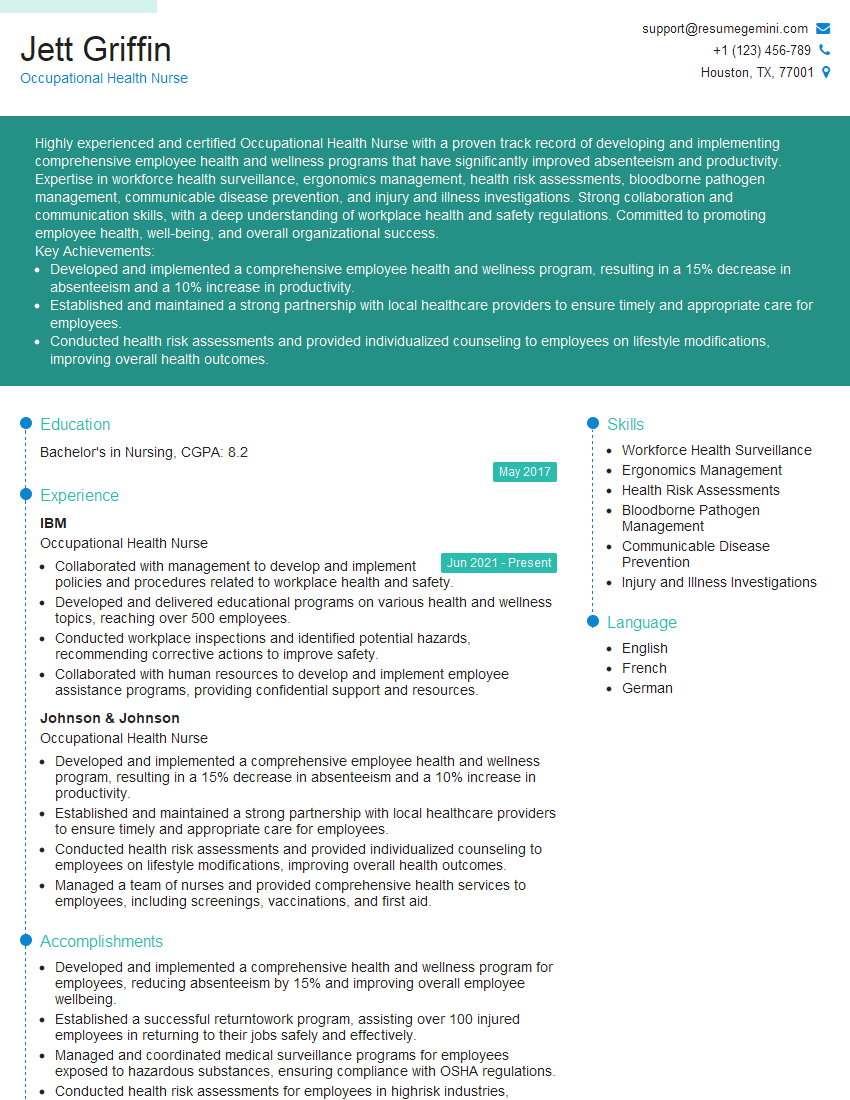Cracking a skill-specific interview, like one for Ergonomics and Musculoskeletal Disorder Prevention, requires understanding the nuances of the role. In this blog, we present the questions you’re most likely to encounter, along with insights into how to answer them effectively. Let’s ensure you’re ready to make a strong impression.
Questions Asked in Ergonomics and Musculoskeletal Disorder Prevention Interview
Q 1. Define ergonomics and its relevance to musculoskeletal disorder prevention.
Ergonomics is the scientific study of people and their working environment. Its goal is to design workplaces and jobs to fit the capabilities and limitations of the human body. In essence, it’s about creating a work environment that’s comfortable, efficient, and safe. Musculoskeletal disorders (MSDs) are injuries and disorders of the muscles, nerves, tendons, joints, cartilage, and spinal discs. Ergonomics plays a crucial role in preventing MSDs by identifying and mitigating workplace factors that can contribute to these injuries. By understanding how people interact with their work environment, we can design jobs and workstations to minimize the risk of strain, overuse, and injury.
For example, imagine a cashier standing for eight hours a day. Ergonomic principles would suggest providing an anti-fatigue mat, adjustable counter height, and perhaps even allowing for short breaks to change posture. This reduces the strain on their legs and back, preventing potential MSDs like back pain or carpal tunnel syndrome.
Q 2. Explain the biomechanical principles underlying musculoskeletal injuries.
Musculoskeletal injuries are often the result of biomechanical stresses exceeding the body’s tolerance limits. This involves several key principles:
- Force: The amount of physical effort required to perform a task. Excessive force, like repeatedly lifting heavy objects, can lead to injury.
- Repetition: Repeated movements, even with minimal force, can cause cumulative trauma. Think of assembly line workers performing the same motion hundreds of times a day.
- Posture: Awkward postures, like prolonged bending or twisting, place undue stress on muscles, tendons, and joints. A prolonged reach for example, while working on a computer could cause neck and shoulder problems.
- Duration: The length of time a task is performed. Prolonged static postures, such as sitting for hours without moving, can restrict blood flow and contribute to muscle fatigue and injury.
- Vibration: Exposure to whole-body or hand-arm vibration can cause damage to blood vessels and nerves.
These factors interact; a small force repeated many times in an awkward posture for a long duration can create a significant risk of injury even greater than a single instance of high force.
Q 3. Describe different ergonomic risk assessment methods.
Several methods exist for assessing ergonomic risks. These often involve a combination of approaches:
- Observation: A trained ergonomist observes workers performing their tasks, noting postures, movements, and use of equipment. This provides a direct visual assessment of potential hazards.
- Interviews and Questionnaires: Gathering information directly from workers about their experiences, symptoms, and perceptions of their jobs. This helps to identify subjective discomfort and potential early signs of MSDs.
- Checklists: Standardized forms that guide the assessment process by focusing on specific ergonomic risk factors. This ensures consistency and completeness.
- Measurement Tools: Using tools such as inclinometers to measure posture angles, dynamometers to measure forces, and motion capture systems to quantify movements, providing objective data on workplace demands.
- Job Task Analysis: A detailed breakdown of the tasks involved in a job, documenting the physical demands and risk factors associated with each element.
The choice of method depends on factors such as budget, time constraints, and the complexity of the task.
Q 4. What are the common causes of musculoskeletal disorders in the workplace?
Common causes of MSDs in the workplace often stem from poor ergonomic design and practices. These include:
- Repetitive movements: Assembly line work, data entry, and other tasks involving repetitive motions are major contributors.
- Forceful exertions: Lifting heavy objects, pushing, pulling, or using excessive force to perform tasks.
- Awkward postures: Prolonged bending, twisting, reaching, or working in uncomfortable positions.
- Prolonged static postures: Maintaining the same posture for extended periods, like sitting at a desk for hours without breaks.
- Vibration: Exposure to hand-arm vibration (e.g., using power tools) or whole-body vibration (e.g., operating heavy machinery).
- Lack of rest and recovery: Insufficient breaks during prolonged work periods, leading to muscle fatigue and strain.
- Poor workplace design: Inadequate workstation setup, poorly designed tools, and lack of adjustments to accommodate individual differences.
It’s important to remember that these factors often act in combination, increasing the risk of MSDs.
Q 5. How do you identify ergonomic hazards in a workplace setting?
Identifying ergonomic hazards requires a systematic approach. This can include:
- Walkthrough Surveys: Physically inspecting the workplace to identify potential hazards such as cluttered workspaces, poorly designed workstations, and inadequate lighting.
- Direct Observation: Observing workers performing their tasks to identify awkward postures, repetitive movements, and forceful exertions.
- Worker Interviews: Talking to workers about their jobs, symptoms, and concerns. This can reveal hidden hazards not readily apparent through observation.
- Reviewing Incident Reports: Analyzing past injuries to identify patterns and contributing factors.
- Analyzing Job Descriptions and Task Analyses: Reviewing the detailed demands of jobs to understand potential ergonomic issues.
A combination of these methods is often necessary to gain a comprehensive understanding of the ergonomic hazards present in a workplace setting. Remember to focus on the interaction between the worker, the task, and the environment.
Q 6. Explain the concept of job demands analysis.
Job demands analysis (JDA) is a systematic process to identify the physical, cognitive, and psychosocial demands of a job. It goes beyond simply observing the tasks; it analyzes the intensity, frequency, and duration of each demand, along with the worker’s control over the pace and methods of work. The goal is to understand how the job contributes to employee stress and the risk of injury. A thorough JDA includes:
- Task Analysis: A detailed description of all the tasks involved in the job.
- Physical Demands Analysis: Assessing the physical demands such as lifting, pushing, pulling, reaching, and repetitive movements.
- Psychosocial Demands Analysis: Evaluating factors such as work pressure, workload, control over work, and social support.
- Worker Capabilities Analysis: Considering the physical and mental capabilities of the workers performing the job.
By analyzing these aspects, the JDA helps identify discrepancies between job demands and worker capabilities, highlighting areas where ergonomic interventions are needed.
Q 7. Describe various ergonomic control measures for reducing MSD risk.
Ergonomic control measures aim to reduce or eliminate MSD risk by modifying the work environment, tools, or tasks. Control measures are categorized into three levels of hierarchy:
- Engineering Controls: These are preferred as they modify the physical environment and equipment. Examples include:
- Workstation design: Adjustable chairs, desks, and monitor stands to promote good posture.
- Tool redesign: Modifying tools to reduce force requirements or awkward postures.
- Automation: Using automated systems to reduce repetitive movements.
- Administrative Controls: These involve changes to work practices and schedules. Examples include:
- Job rotation: Varying tasks to prevent repetitive strain injuries.
- Work-rest schedules: Providing regular breaks to reduce fatigue.
- Training programs: Educating workers about proper lifting techniques and ergonomic principles.
- Personal Protective Equipment (PPE): This is the last resort, providing protection to the individual worker. Examples include:
- Back supports: Offering lumbar support to maintain good posture.
- Gloves: Reducing hand vibrations and improving grip.
Implementing a multi-faceted approach using controls from all three levels is often the most effective strategy for minimizing MSD risks.
Q 8. How do you prioritize ergonomic interventions based on risk levels?
Prioritizing ergonomic interventions involves a risk assessment process. We identify tasks and workstations posing the highest risk of musculoskeletal disorders (MSDs). This isn’t simply about the number of reported injuries, but a comprehensive evaluation. Think of it like a hospital triage system – the most critically injured patients are seen first.
- Step 1: Hazard Identification: We systematically identify potential hazards through job analysis, observation, and worker interviews. This includes assessing postures (prolonged reaching, awkward twisting), repetitive movements, forceful exertions, and vibration exposure.
- Step 2: Risk Assessment: We use established tools like the Rapid Entire Body Assessment (REBA) or the Rapid Upper Limb Assessment (RULA) to quantitatively score the risk level associated with each task. Higher scores indicate higher risk, guiding our prioritization. We also consider factors like the duration of exposure and the force involved.
- Step 3: Prioritization Matrix: We create a matrix ranking tasks based on both risk level (high, medium, low) and the number of employees affected. This matrix clarifies which interventions deserve immediate attention (high risk, many employees) versus those that can be addressed later (low risk, few employees).
- Step 4: Intervention Implementation: Interventions are implemented in a phased approach, starting with high-priority tasks. This could involve adjusting workstation setup, introducing assistive devices, providing training, or implementing administrative controls like work rotation.
Example: In a manufacturing plant, we might prioritize redesigning a high-risk assembly line (high risk, many employees) before addressing a less demanding packaging station (low risk, few employees), even if the packaging station also has some ergonomic shortcomings.
Q 9. What are the key elements of an effective ergonomics program?
A successful ergonomics program is multifaceted, acting as a preventative shield against MSDs. It’s not a one-time fix, but an ongoing process of assessment, intervention, and evaluation.
- Management Commitment: Senior leadership must actively support and resource the program. It’s not enough to just say ergonomics is important; resources – both financial and personnel – are crucial.
- Ergonomic Job Hazard Analysis: A systematic identification of ergonomic hazards through observation, checklists, and worker input. Think of it as a comprehensive safety audit, but specifically focused on musculoskeletal risks.
- Workstation Design and Modification: Adjusting workstations to accommodate individual worker needs, including chair height, monitor placement, keyboard position, and tool accessibility. This is about tailoring the workplace to the person, not the other way around.
- Employee Training and Education: Equipping employees with the knowledge and skills to understand MSD risks and practice good posture and lifting techniques. Training should be engaging and cover practical applications.
- Monitoring and Evaluation: Regularly assessing the effectiveness of interventions. This involves tracking injury rates, conducting follow-up assessments, and making adjustments as needed. Think of it as continuous improvement.
- Record Keeping and Documentation: Maintaining comprehensive records of assessments, interventions, and evaluations. This is vital for demonstrating compliance and identifying trends.
Example: A well-run ergonomics program in an office setting might include providing adjustable chairs and standing desks, conducting regular workstation assessments, offering training on proper posture and computer use, and tracking MSD-related incidents to measure effectiveness.
Q 10. Explain the importance of employee participation in ergonomics programs.
Employee participation is paramount. Workers are the ones directly experiencing the physical demands of their jobs, making their insights invaluable. Ignoring their input is like building a house without consulting the people who will live in it.
- Improved Accuracy of Assessments: Employees can provide crucial information about their tasks, work habits, and any discomfort they experience, ensuring a more accurate ergonomic assessment. They know their job better than anyone.
- Increased Buy-in and Compliance: When employees are involved in designing solutions, they are more likely to adopt and adhere to the ergonomic changes implemented. It’s a matter of ownership and shared responsibility.
- Enhanced Program Effectiveness: Employees’ feedback can help identify overlooked risks and improve the effectiveness of implemented interventions. It’s about collective problem-solving.
- Reduced MSD Incidence: By actively involving employees, the program’s impact can be maximized, leading to a reduction in MSD-related injuries and lost workdays.
Example: In a warehouse setting, including employees in the selection of new lifting equipment or in developing new work procedures can dramatically improve the adoption rate and effectiveness of the changes.
Q 11. Describe different types of personal protective equipment (PPE) used in ergonomics.
Personal Protective Equipment (PPE) in ergonomics focuses on mitigating the risk of MSDs. While engineering controls (e.g., workstation redesign) are preferred, PPE sometimes serves as a supplementary layer of protection.
- Back Supports: These provide lumbar support to help maintain proper posture during prolonged sitting or standing. It’s important to choose a back support that fits properly and doesn’t restrict movement excessively.
- Wrist Supports: These can help reduce strain on the wrists and hands during repetitive tasks, especially for individuals who use keyboards or other hand tools extensively.
- Gloves: Anti-vibration gloves can reduce the impact of hand-arm vibration, while other gloves can improve grip and reduce hand fatigue. Selecting the appropriate glove for the specific task is crucial.
- Knee Pads: These offer protection during tasks that require kneeling or working on the floor, reducing strain on the knees.
- Lifting Belts: These are designed to assist in lifting heavy objects, supporting the lower back and reducing strain. However, they should not be relied upon as a primary means of injury prevention, and proper lifting techniques remain crucial.
Important Note: PPE should never be considered a replacement for proper ergonomic design and training. It’s a supplementary measure, not a primary solution.
Q 12. How do you measure and analyze posture and movement during an ergonomic assessment?
Measuring and analyzing posture and movement during an ergonomic assessment involves both observational techniques and sometimes more sophisticated technologies.
- Observational Methods: We use standardized checklists and rating systems (like REBA or RULA) to observe and document posture, assessing factors such as trunk flexion, neck posture, and limb positions. Video recording can be helpful for detailed analysis.
- Motion Capture Systems: These use markers and cameras to track body movement in three dimensions. This provides quantitative data on joint angles, movement speeds, and other factors that contribute to MSD risk.
- Electromyography (EMG): This technique measures muscle activity to assess muscle fatigue and strain. It’s particularly useful in identifying muscles at high risk of overload.
- Force Plate Analysis: This measures the forces exerted by the body during lifting or other tasks. This helps us quantify the physical demands placed on the worker.
Example: Using REBA, we might observe an assembly line worker repeatedly reaching overhead and record this as a high risk posture, while motion capture can provide more precise data on the range of motion and speed of the reach.
Q 13. What are the limitations of self-reported musculoskeletal symptoms?
Self-reported musculoskeletal symptoms (like pain or discomfort) are valuable, but they have limitations. Think of it like asking someone to describe a headache – their description may not fully capture the underlying cause or severity.
- Subjectivity: Individual perceptions of pain and discomfort can vary significantly, influenced by factors like pain tolerance, emotional state, and cultural background.
- Recall Bias: Employees may not accurately recall the timing or circumstances of symptom onset or accurately report the intensity or frequency of symptoms.
- Over- or Underreporting: Workers may underreport symptoms to avoid appearing weak or to maintain productivity, or conversely, may overreport due to secondary gain (e.g., worker’s compensation claims).
- Lack of Objective Measures: Self-reports don’t provide objective measures of physical factors contributing to MSDs (e.g., joint angles, muscle forces). They provide a valuable piece of the puzzle, but not the entire picture.
Example: One employee might experience significant discomfort from a task but underreport it due to fear of job repercussions, while another might overreport due to a pending worker’s compensation claim.
Q 14. How do you evaluate the effectiveness of ergonomic interventions?
Evaluating the effectiveness of ergonomic interventions requires a multi-faceted approach that goes beyond simply asking if employees feel better.
- Injury Rate Tracking: Monitor the incidence of MSDs before, during, and after implementing interventions. A significant reduction in MSDs is a strong indicator of success.
- Post-Intervention Assessments: Conduct follow-up ergonomic assessments to evaluate whether the implemented changes have reduced ergonomic risk factors. Are postures improved? Are repetitive movements reduced?
- Employee Feedback: Gather feedback from employees to understand their experience with the interventions and identify any areas for improvement. Are they finding the changes helpful? Are there any unforeseen consequences?
- Productivity Measures: In some cases, improved ergonomics may lead to increased productivity. However, productivity changes are not always directly attributable to ergonomic interventions.
- Quantitative Data: If possible, use objective measures like motion capture or EMG data to demonstrate the impact of interventions on physical demands and muscle activity.
Example: After implementing new workstations and training, we might see a 50% reduction in reported back pain incidents, a positive shift in posture assessment scores (e.g., using REBA), and improved employee satisfaction scores – all indicators of a successful intervention.
Q 15. Describe your experience with using ergonomic assessment tools and software.
My experience with ergonomic assessment tools and software is extensive. I’ve utilized a range of tools, from simple checklists for rapid assessments of workstation setups to sophisticated software packages capable of conducting detailed biomechanical analyses. For example, I’ve used the RULA (Rapid Upper Limb Assessment) and REBA (Rapid Entire Body Assessment) checklists for quick evaluations of posture and risk factors. These are particularly useful for large-scale workplace assessments where speed and efficiency are crucial.
More complex software, like those employing 3D motion capture and musculoskeletal modelling, allow for much more in-depth analysis. I’ve worked with programs that simulate the forces acting on the body during specific tasks, helping to identify potential problem areas before they manifest as injuries. These advanced tools are invaluable for designing new workstations or modifying existing ones to minimize risk. For instance, in one project, using 3D modelling software, we were able to demonstrate how a seemingly minor change to a chair’s backrest angle significantly reduced the load on the lumbar spine during prolonged computer work.
My experience also includes using software for data management and reporting. This allows for efficient tracking of ergonomic interventions, monitoring their effectiveness, and providing clear, data-driven reports to management and stakeholders. This ensures that our efforts are not only well-informed but also demonstrably effective in reducing musculoskeletal disorders.
Career Expert Tips:
- Ace those interviews! Prepare effectively by reviewing the Top 50 Most Common Interview Questions on ResumeGemini.
- Navigate your job search with confidence! Explore a wide range of Career Tips on ResumeGemini. Learn about common challenges and recommendations to overcome them.
- Craft the perfect resume! Master the Art of Resume Writing with ResumeGemini’s guide. Showcase your unique qualifications and achievements effectively.
- Don’t miss out on holiday savings! Build your dream resume with ResumeGemini’s ATS optimized templates.
Q 16. Explain the relationship between ergonomics and workplace safety.
Ergonomics and workplace safety are inextricably linked. Workplace safety aims to prevent accidents and injuries, while ergonomics focuses on designing workspaces and tasks to fit the capabilities and limitations of the human body. Poor ergonomics directly contributes to workplace safety issues.
For instance, improper workstation setup can lead to musculoskeletal disorders (MSDs) like carpal tunnel syndrome or back pain. These conditions can reduce productivity, increase absenteeism, and even lead to permanent disability. They are also a direct cause of workplace injuries. A poorly designed workstation might necessitate awkward postures or repetitive movements, increasing the likelihood of slips, trips, falls, or strains. Conversely, a well-designed ergonomic workstation, tailored to the individual and their task, minimizes these risks. A safe workplace isn’t just about having safety equipment; it’s also about optimizing the work environment to support the physical well-being of the workers.
Consider a warehouse setting: Poor ergonomic design of lifting tasks can lead to back injuries. Implementing ergonomic principles – such as using proper lifting techniques, providing appropriate lifting aids, and optimizing the weight and reach of objects – dramatically reduces the incidence of such injuries, boosting both productivity and safety.
Q 17. How do you communicate ergonomic findings and recommendations to management and workers?
Communicating ergonomic findings and recommendations effectively is crucial for successful implementation. My approach involves tailoring the communication style to the audience. When presenting to management, I emphasize the return on investment (ROI) of ergonomic improvements, highlighting reductions in absenteeism, workers’ compensation costs, and increased productivity. I use data-driven reports, cost-benefit analyses, and clear visualizations of problem areas and proposed solutions.
When communicating with workers, I use clear, concise language, avoiding technical jargon. I involve them in the process by actively seeking their feedback and input. I explain the rationale behind recommendations, demonstrating how the changes will improve their comfort, health, and well-being. I might use visual aids, demonstrations, or even role-playing to make the information more accessible and engaging. Interactive workshops and training sessions are also incredibly effective in fostering understanding and buy-in.
For example, when recommending the introduction of adjustable-height workstations, I would not only present the data showing reduced MSD risk but also allow employees to test out the workstations and provide their feedback before a final decision is made. This participative approach significantly increases the likelihood of acceptance and successful implementation.
Q 18. How do you handle disagreements or resistance to ergonomic changes?
Disagreements or resistance to ergonomic changes are common. My approach is to address concerns proactively and collaboratively. I start by actively listening to objections and acknowledging their validity. I then try to address concerns through a combination of education, negotiation, and compromise.
Often, resistance stems from a lack of understanding, misconceptions about the cost or feasibility of changes, or concerns about workflow disruptions. I address these concerns by providing more information, demonstrating the practicality of solutions, and offering support during the transition. Sometimes, compromises are needed. Perhaps a full-scale workstation redesign isn’t feasible immediately, but implementing smaller, less disruptive changes can still significantly improve the situation.
For example, if workers resist the use of new lifting equipment due to concerns about workflow efficiency, I might demonstrate how the new equipment can actually save time and reduce effort in the long run. If cost is a concern, I’ll explore more affordable options or demonstrate the long-term cost savings associated with reduced injury rates. This collaborative, problem-solving approach is far more effective than simply imposing changes from above.
Q 19. Describe your experience with different types of ergonomic training and education programs.
My experience encompasses a wide range of ergonomic training programs. I’ve designed and delivered both classroom-based and online training sessions, targeting different employee groups and levels of knowledge. For example, I’ve developed introductory workshops focusing on basic workstation ergonomics, covering topics like proper posture, keyboard positioning, and monitor placement.
I’ve also conducted more advanced training sessions for supervisors and managers, emphasizing their roles in maintaining a safe and ergonomic work environment. This training often includes strategies for identifying ergonomic hazards, conducting risk assessments, and implementing ergonomic improvements. In addition, I’ve created specialized training programs focusing on specific tasks or industries, such as material handling, data entry, or nursing. These tailor-made programs utilize task-specific demonstrations, videos, and hands-on exercises to maximize their effectiveness.
The use of interactive simulations and virtual reality (VR) has also proven extremely beneficial in certain applications. These allow employees to practice proper techniques in a safe and controlled environment without risk of injury, enhancing training engagement and knowledge retention.
Q 20. What are the legal and regulatory requirements related to ergonomics in your area?
Legal and regulatory requirements concerning ergonomics vary widely depending on location. In many jurisdictions, there are general duty clauses requiring employers to provide a safe and healthy work environment, which implicitly includes adhering to ergonomic principles. Specific regulations often target high-risk industries or tasks. For example, there might be specific regulations concerning manual material handling, repetitive strain injuries, or the use of display screen equipment (DSE).
These regulations frequently require employers to conduct risk assessments, implement control measures (engineering controls, administrative controls, personal protective equipment), provide employee training, and maintain records of incidents and interventions. Failure to comply can result in penalties, including fines and legal action. Staying current on these regulations is crucial, requiring regular review of relevant legislation and guidelines. I typically consult relevant government agencies and professional organizations to ensure that my recommendations align with all applicable regulations and best practices.
Understanding these legal aspects is paramount in ensuring that ergonomic interventions are not only effective but also legally compliant. This requires a thorough knowledge of the specific regulations relevant to the client’s industry and location.
Q 21. Explain the importance of considering individual differences in ergonomic design.
Considering individual differences is critical for effective ergonomic design. People vary significantly in terms of anthropometry (body size and proportions), strength, and pre-existing health conditions. A ‘one-size-fits-all’ approach simply won’t work. Ignoring these variations can lead to discomfort, injury, and reduced productivity.
For instance, a workstation designed for a tall individual may be unsuitable for someone shorter, resulting in awkward postures and strain. Similarly, a task requiring significant physical strength may be impossible for someone with limited physical capabilities. To account for these differences, ergonomic assessments should be individualized. This often involves measuring individuals’ anthropometric dimensions and considering their specific task requirements. Adjustable equipment, such as height-adjustable workstations, adjustable chairs, and keyboard trays, is essential to accommodate this variability.
In practice, I would conduct individual workstation assessments, taking measurements such as sitting height, arm length, and leg length to ensure the chair, desk, and monitor are properly positioned for each individual. For tasks involving repetitive movements or heavy lifting, I would assess the individual’s strength and capacity to determine safe working limits and recommend appropriate assistive devices or work modifications. This personalized approach is crucial for ensuring a healthy and productive work environment for everyone.
Q 22. How do you adapt ergonomic principles to different work environments and tasks?
Adapting ergonomic principles requires a holistic approach, considering the specific demands of each work environment and task. It’s not a one-size-fits-all solution. We need to analyze the job, the tools used, and the worker’s individual characteristics. For example, a surgeon’s workstation needs vastly different considerations than an office worker’s setup. My approach involves a systematic process:
- Job analysis: Thoroughly documenting the tasks, tools, postures, and movements involved.
- Environmental assessment: Evaluating factors like lighting, temperature, noise levels, and workspace layout.
- Worker assessment: Considering individual anthropometrics (body measurements), physical capabilities, and pre-existing conditions. This includes understanding any specific needs or limitations.
- Control recommendations: Designing or recommending modifications to workstations, tools, and work processes to minimize risk factors. This could involve adjusting chair height, keyboard placement, monitor position, or implementing work-rest schedules.
- Training and education: Ensuring workers understand and correctly implement ergonomic principles to prevent musculoskeletal disorders (MSDs).
For instance, in a manufacturing setting, we might implement adjustable height workbenches, anti-fatigue mats, and provide training on proper lifting techniques. In an office environment, we’d focus on proper chair adjustments, monitor placement, and keyboard positioning, and possibly introduce standing desks or ergonomic keyboards. The key is tailoring the solution to the specific challenges of the work setting and the individuals performing the work.
Q 23. What is your experience with conducting ergonomic workstation assessments?
I have extensive experience conducting ergonomic workstation assessments, having completed over 100 assessments across diverse industries. My process typically involves:
- Observation: Directly observing the worker performing their tasks to identify potential risk factors.
- Interview: Speaking with the worker to understand their experiences, any discomfort they’re experiencing, and their work habits.
- Measurement: Using tools like tape measures and goniometers to objectively assess posture and workspace dimensions. This data ensures a concrete foundation for my recommendations.
- Documentation: Thoroughly documenting my findings, including photographs and detailed notes, allowing for a comprehensive report.
- Recommendations: Developing tailored recommendations based on my observations and measurements, addressing specific risk factors.
In one particular case, I assessed a call center where employees reported widespread neck and shoulder pain. Through observation and measurement, I found that monitors were positioned too low, forcing workers into awkward postures. My recommendations included raising monitor heights and providing adjustable chairs, which significantly reduced reported pain levels.
Q 24. Explain the difference between proactive and reactive ergonomics approaches.
Proactive and reactive ergonomics differ significantly in their approach to MSD prevention. Reactive ergonomics addresses problems *after* they occur, typically in response to injuries or reported discomfort. It’s a ‘fix-it’ approach. Proactive ergonomics, on the other hand, anticipates potential problems *before* they arise, implementing preventive measures to create a healthier and safer work environment. It’s a ‘prevent-it’ approach.
Think of it like this: reactive ergonomics is like calling a plumber after a pipe bursts, while proactive ergonomics is like regularly maintaining your plumbing system to prevent bursts in the first place. Proactive approaches are significantly more cost-effective in the long run, reducing healthcare costs, lost productivity, and worker compensation claims.
Reactive ergonomics might involve fitting an employee with a wrist splint after they develop carpal tunnel syndrome. Proactive ergonomics would involve designing the workstation to prevent carpal tunnel syndrome from ever developing. This could involve ergonomic keyboards, adjustable workstations, and frequent breaks.
Q 25. Describe your experience with designing ergonomic tools and equipment.
I’ve been involved in several projects designing and modifying ergonomic tools and equipment. This has involved collaboration with engineers, manufacturers, and end-users to create tools that are both effective and comfortable to use. A key aspect of this work is using anthropometric data to ensure the design accommodates a wide range of body sizes and shapes.
For example, I worked on a project to redesign a hand-held assembly tool. The initial design led to repetitive strain injuries. Through user feedback and biomechanical analysis, we redesigned the tool with a more ergonomic grip, reducing the strain on the hand and wrist. This involved iterative prototyping and user testing to ensure the final design met our ergonomic goals.
Designing ergonomic tools and equipment requires a deep understanding of biomechanics, human factors, and manufacturing processes. It’s a multidisciplinary effort that demands creativity and attention to detail. Success is measured not only by the functionality of the tool but also by its impact on user health and comfort.
Q 26. How do you stay current with the latest research and advancements in ergonomics?
Staying current in the rapidly evolving field of ergonomics requires continuous learning. My strategies include:
- Professional memberships: I’m an active member of professional organizations like the Human Factors and Ergonomics Society (HFES) and participate in conferences and workshops.
- Peer-reviewed journals: I regularly read peer-reviewed journals like the Applied Ergonomics and the International Journal of Industrial Ergonomics to stay abreast of the latest research.
- Online resources: I utilize online resources such as databases like PubMed and professional organization websites for information.
- Continuing education: I actively seek out and participate in continuing education courses and training programs to expand my knowledge and skills.
- Networking: I maintain a strong network of colleagues and professionals in the field, exchanging information and best practices.
This multifaceted approach ensures that I remain at the forefront of ergonomic advancements and best practices, benefiting my clients and projects.
Q 27. What are the ethical considerations in ergonomics practice?
Ethical considerations in ergonomics practice are paramount. My core principles include:
- Confidentiality: Protecting the privacy of worker information obtained during assessments and consultations.
- Objectivity: Providing unbiased recommendations based on evidence and data, avoiding conflicts of interest.
- Competence: Only undertaking tasks within my area of expertise, acknowledging limitations and seeking further expertise if needed.
- Informed consent: Ensuring workers fully understand the purpose and procedures of ergonomic assessments before participation.
- Transparency: Clearly communicating my findings and recommendations to both workers and employers.
- Beneficence: Prioritizing the well-being and safety of workers.
A crucial aspect is avoiding situations where recommendations are influenced by cost concerns at the expense of worker health. Ethical ergonomics prioritizes worker well-being above all else.
Q 28. Describe a time you had to overcome a significant challenge in an ergonomics project.
In one project, I faced a significant challenge while working with a large manufacturing company. They were resistant to implementing many of my ergonomic recommendations due to perceived high costs. The workers were experiencing high rates of carpal tunnel syndrome from repetitive tasks on an assembly line. My initial recommendations, including redesigning the workstation and providing specialized tools, were deemed too expensive.
To overcome this, I developed a phased implementation plan. We started with low-cost interventions such as adjusting existing equipment, implementing short work-rest cycles, and providing training on proper posture. This demonstrated improvements in worker comfort and reduced injury rates. This success built trust and made a stronger case for the more substantial changes, securing management buy-in for the longer-term improvements. The phased approach, while initially slower, ultimately resulted in significant improvements in worker health and productivity with greater acceptance and collaboration.
Key Topics to Learn for Ergonomics and Musculoskeletal Disorder Prevention Interview
- Workplace Assessment & Analysis: Understanding methods for evaluating workplace setups, identifying risk factors for MSDs, and using tools like NIOSH lifting equation.
- Musculoskeletal Disorders (MSDs): Deep knowledge of common MSDs (e.g., Carpal Tunnel Syndrome, Tendonitis, Back pain), their causes, symptoms, and preventative measures.
- Ergonomic Principles & Design: Applying principles of biomechanics, anthropometry, and human factors to design workstations, tools, and processes that minimize MSD risk. This includes understanding workstation adjustments, proper lifting techniques, and workplace layout.
- Risk Management & Control Strategies: Developing and implementing strategies to mitigate MSD risks, including administrative controls (training, job rotation), engineering controls (equipment modifications), and personal protective equipment (PPE).
- Legislation & Regulations: Familiarity with relevant OSHA or other regional safety regulations related to ergonomics and MSD prevention.
- Data Collection & Analysis: Understanding methods for collecting ergonomic data (e.g., surveys, observations, physiological measurements) and analyzing the data to identify trends and inform interventions.
- Return-to-Work Programs: Knowledge of developing and implementing programs to facilitate safe and gradual return to work for employees recovering from MSDs.
- Communication & Training: Effective communication skills to educate employees about ergonomics and MSD prevention. Designing and delivering engaging training programs.
- Emerging Technologies in Ergonomics: Awareness of new technologies and approaches in ergonomics, such as wearable sensors and virtual reality training.
Next Steps
Mastering Ergonomics and Musculoskeletal Disorder Prevention is crucial for a successful and rewarding career. This field offers significant opportunities for growth and impact, allowing you to contribute to a safer and healthier work environment. To enhance your job prospects, crafting a strong, ATS-friendly resume is essential. We highly recommend using ResumeGemini to build a professional and impactful resume that showcases your skills and experience effectively. ResumeGemini provides examples of resumes tailored specifically to Ergonomics and Musculoskeletal Disorder Prevention to help you create a winning application.
Explore more articles
Users Rating of Our Blogs
Share Your Experience
We value your feedback! Please rate our content and share your thoughts (optional).
What Readers Say About Our Blog
good
